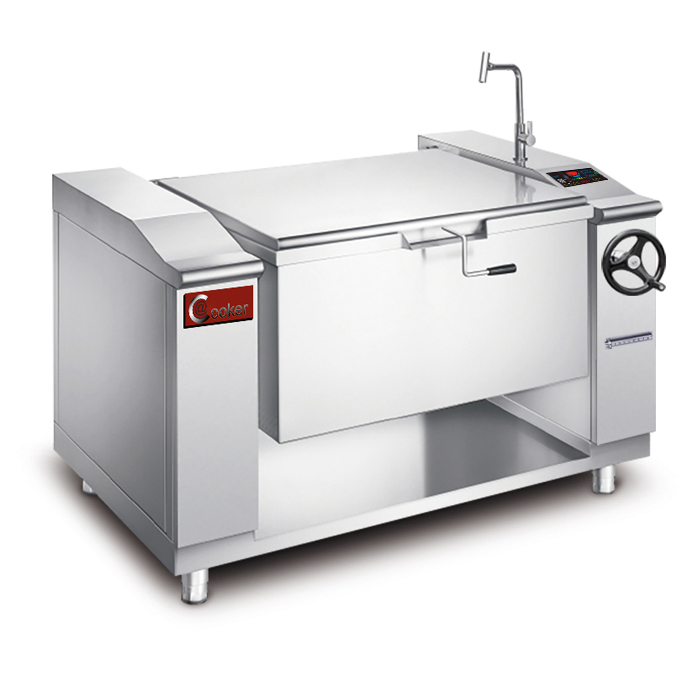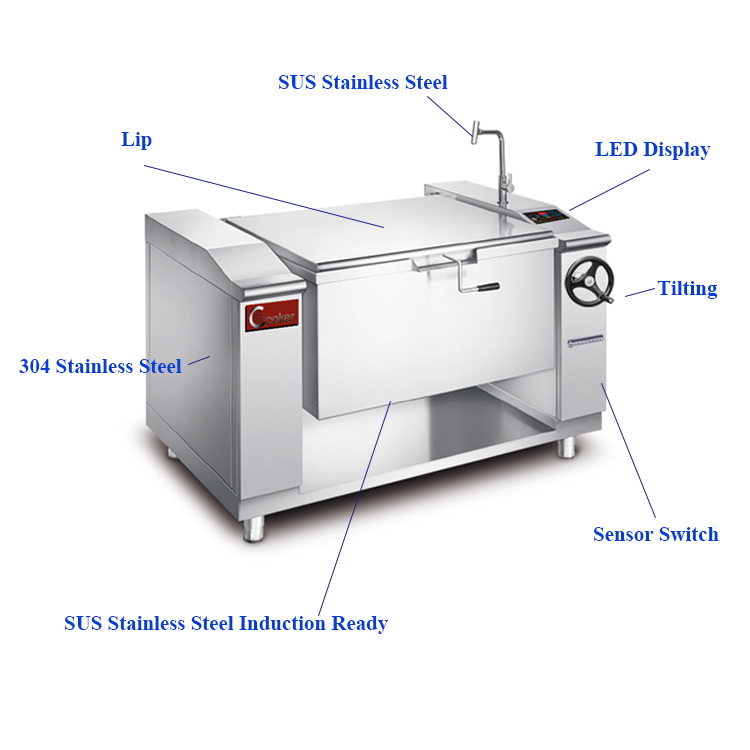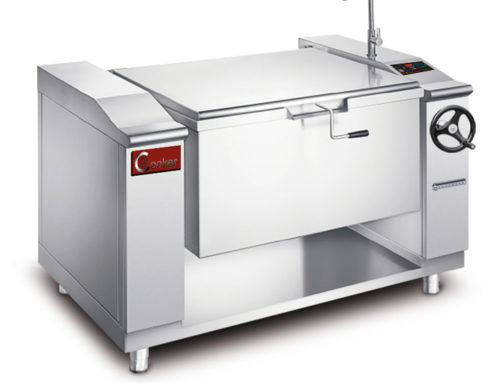Key Differences Between Electric, Gas, and Induction-Powered Commercial Bratt Pans
Choosing the right commercial bratt pans means matching the heating technology to your kitchen’s infrastructure, cooking needs, and efficiency goals. Electric, gas, and induction-powered models each have unique strengths—from precise temperature control (electric) to rapid heating (gas) and energy efficiency (induction). At AT Cooker, a leading manufacturer of commercial bratt pans (including the popular electric tilting ATT-ABT-BP 300 model), we’ve helped hundreds of catering and restaurant clients select the right technology for their operations. In this guide, we’ll break down the critical differences between the three types, highlight how they perform in real commercial kitchens, and show how AT Cooker’s electric models stand out for reliability and versatility.
Core Differences: Electric vs. Gas vs. Induction Commercial Bratt Pans
| Feature | Electric Commercial Bratt Pans | Gas-Powered Commercial Bratt Pans | Induction-Powered Commercial Bratt Pans |
|---|---|---|---|
| Heating Principle | Resistive heating elements (electric coils) | Open flame (natural gas/propane combustion) | Electromagnetic fields (heats pan directly) |
| Temperature Control | Precise (±5°F), programmable via sensors | Moderate (±15°F), manual flame adjustment | Very precise (±2°F), instant adjustments |
| Energy Efficiency | 70-85% (heat retained in elements) | 45-55% (heat lost to air/flames) | 90-95% (no heat loss to surroundings) |
| Heating Speed | Moderate (10-15 mins to 350°F) | Fast (5-8 mins to 350°F) | Very fast (3-5 mins to 350°F) |
| Installation Needs | 3-phase power (208V/380V), no ventilation | Gas line + commercial ventilation (hood) | 3-phase power (208V/380V), flat surface |
| Ambient Heat | Low (heat focused on pan) | High (flames emit heat to kitchen) | Very low (only pan heats up) |
| Maintenance | Low (fewer moving parts, no gas lines) | High (clean burners, check gas connections) | Low (no heating elements, easy-to-wipe surface) |
| Ideal For | Delicate cooking, programmable batches | Rapid high-heat cooking, large volumes | Fast, efficient, low-heat kitchens |
| Upfront Cost | Medium ($12,000-$45,000) | Low ($8,000-$30,000) | High ($15,000-$50,000) |
Electric Commercial Bratt Pans: Precision & Programmability
Electric commercial bratt pans rely on resistive heating elements (embedded in the pan’s base) to generate heat, offering unmatched temperature control and consistency. This makes them ideal for delicate cooking processes—like braising meats, simmering sauces, or blanching vegetables—where even slight temperature fluctuations can ruin batches. They also excel in kitchens where precise repeatability is key, such as chain restaurants or catering operations that need consistent results across every dish.
- Precise Temperature Control: Adjustable from 194°F to 572°F (90°C to 300°C) via sensor switches, with real-time LED display—critical for dishes like caramelized onions or slow-braised pork that need steady heat.
- Motorized Tilting: Unlike manual tilting in gas models, this electric electric tilting bratt pan uses a motorized mechanism to pour contents easily, reducing staff strain when serving large batches (e.g., 300L of soup).
- Programmable Automation: 10-hour digital countdown timer and auto-fault detection let staff set cooking cycles (e.g., 2-hour braise) and walk away—ideal for commercial catering bratt pans that handle back-to-back events.
- Low Maintenance: 304# stainless steel body (easy to wipe clean) and no gas lines/burners mean less upkeep—AT Cooker backs this with a 5-year warranty, far longer than gas models’ 1-2 year coverage.
For a 150-seat restaurant, this model cuts cooking time by 20% compared to gas pans when preparing large batches of sauce, thanks to consistent heat that avoids burning or undercooking.
Key Advantage: Electric models like AT Cooker’s ATT-ABT-BP 300 need no ventilation hood, reducing installation costs by $3,000-$5,000 compared to gas pans. They also work in kitchens without gas lines (e.g., urban cafes or temporary catering sites).
Gas-Powered Commercial Bratt Pans: Speed & High Heat
Gas commercial bratt pans use open flames (natural gas or propane) to heat the pan, delivering rapid heat-up times and high maximum heat output. This makes them a traditional choice for high-volume operations—like stadiums, military bases, or busy diners—that need to cook large batches quickly (e.g., frying 50 lbs of chicken or searing large cuts of meat). They also have lower upfront costs than electric or induction models, which can appeal to budget-conscious startups.
- Installation Costs: Require a dedicated gas line and commercial ventilation hood (to remove smoke and carbon monoxide), adding $5,000-$10,000 to upfront expenses—costs electric models avoid.
- Temperature Inconsistency: Flame heat is harder to control (±15°F), leading to hot spots that burn food or undercooked sections—risky for delicate dishes like sauces or vegetables.
- High Maintenance: Burners clog with food debris, gas lines need regular leak checks, and ventilation hoods require monthly cleaning—adding $800-$1,200 in annual maintenance costs.
- Ambient Heat: Open flames emit大量 heat into the kitchen, increasing air conditioning costs and making staff uncomfortable during long shifts (e.g., 8-hour catering events).
AT Cooker’s Perspective on Gas Bratt Pans
While AT Cooker focuses on electric and induction commercial bratt pans (due to their long-term efficiency), we recognize gas pans have a role in specific settings (e.g., remote locations with no 3-phase power). However, our electric models (like the ATT-ABT-BP 300) now match gas’s heat output (up to 30KW) while offering better control—making gas a less practical choice for most modern kitchens.
Induction-Powered Commercial Bratt Pans: Efficiency & Speed
Induction commercial bratt pans use electromagnetic fields to heat the pan directly (instead of the air around it), making them the most energy-efficient and fastest-heating option. They work only with compatible cookware (ferromagnetic materials like 304# stainless steel, which AT Cooker’s pans use) and generate almost no ambient heat—transforming kitchen comfort during extended cooking periods (e.g., 12-hour catering events). Their precision and speed make them ideal for high-end restaurants or busy catering operations that prioritize productivity and energy savings.
- 95% Energy Efficiency: Uses far less power than electric (70-85%) or gas (45-55%) models—for a kitchen using the pan 6 hours daily, this saves $1,500-$2,000 in annual energy costs compared to gas.
- Instant Temperature Adjustments: Changes heat in seconds (vs. 1-2 minutes for electric/gas), perfect for dishes that need quick heat shifts (e.g., searing meat then reducing heat to braise).
- Safe Design: No open flames or hot heating elements—reducing burn risks for staff, a critical feature in busy commercial catering bratt pans where multiple team members work around the equipment.
- Flat Cooking Surface: Easy to clean and compatible with AT Cooker’s 304# stainless steel pans—no need for specialized cookware beyond what’s included with the unit.
Key Limitation: Induction models have the highest upfront cost ($15,000-$50,000) and require 3-phase power—making them less suitable for small kitchens or operations with limited electrical infrastructure. However, their long-term energy savings often offset the upfront investment within 2-3 years.
How to Choose: Electric vs. Gas vs. Induction
The right commercial bratt pans depend on three critical factors: your kitchen’s infrastructure, energy costs, and cooking style. Use this decision framework to select the best option:
- Choose Electric If: You need precise temperature control, have 3-phase power (208V/380V), and want low maintenance. Ideal for restaurants, hotels, and catering companies that cook delicate dishes or need programmable batches. AT Cooker’s ATT-ABT-BP 300 is a top choice here, with its motorized tilting and 5-year warranty.
- Choose Gas If: You have existing gas lines and ventilation, need rapid high heat, and prioritize low upfront costs. Best for remote locations with no 3-phase power or operations that only cook high-heat dishes (e.g., fried foods). Note: Factor in $5,000-$10,000 in installation and maintenance costs over 5 years.
- Choose Induction If: You have 3-phase power, want maximum efficiency, and prioritize kitchen comfort. Ideal for high-end restaurants or busy catering operations that cook quickly and value safety. Best for teams willing to invest upfront for long-term savings.
Conclusion: Electric Commercial Bratt Pans for Most Modern Kitchens
For most commercial kitchens—from restaurants to catering companies—electric commercial bratt pans strike the best balance of precision, low maintenance, and long-term value. Gas models offer speed but require costly infrastructure and maintenance, while induction models excel in efficiency but have high upfront costs. AT Cooker’s electric tilting bratt pans (like the ATT-ABT-BP 300) address the core needs of commercial operations: precise temperature control for consistent cooking, motorized tilting for ease of use, and durable 304# stainless steel construction that lasts 7-10 years.
Whether you’re looking to buy commercial bratt pans for a new restaurant or upgrade existing equipment, AT Cooker’s electric models deliver on performance and reliability. Our 5-year warranty and global service network ensure your investment is protected, while features like auto-fault detection and programmable timers reduce operational stress for your team.
Ready to select the right commercial bratt pans for your kitchen? Contact AT Cooker today to discuss your cooking needs and get a custom quote. With 20 years of experience in commercial kitchen equipment, we’re your trusted partner for efficient, durable cooking solutions.


